Inspired Giving



Mr. and Mrs. Darryl F. Allen
Mr. and Mrs. Richard P. Anderson
Mr. and Mrs. Robert M. Anspach
Mr. Mark Armstrong
Ms. Paige Armstrong
Ms. Barbara J. Baker
Mr.* and Mrs. George P. Ballas
Mrs. Marj Baril
Mr. and Mrs. John Bearss
Mr.* and Mrs. Thomas N. Bentley
Mr.* and Mrs. Edwin M. Bergsmark
Mrs. Alvin Bippus*
Mr. and Mrs. James W. Blumer
Mr. and Mrs.* William W. Boeschenstein
Mr. and Mrs. Pier C. Borra
Mr. Fred W. Bostleman*
Mr. and Mrs Calvin K. Brauer
Mr.* Elgin C. and Dr.* Helen L. Brooks
Dr. and Mrs. G. Mark Burton
Mr.* and Mrs.* Melvin Burwell
Mr. and Mrs. William Carroll
Mr. and Mrs. George L. and Leslie A. Chapman
Ms. Deborah R. Chapman
Dr. and Mrs. John T. Chiles
Mr. and Mrs. Steven R. Coffin
Mr.* and Mrs.* Edmund Collins
Mr. and Mrs. Joseph V. Conda
Ms. Susan L. Conda
Mr. William S. Cosgrove and Ms. Kimberlee A. Collins
Mr. Howard Cross and Ms. Deborah Workman
Mrs. Dora Crowther
Mr. and Mrs. Ed Danziger
Dr. and Mrs. Paul V. Daverio
Dr. and Mrs. William Davis
Mr. Guy-Michael B. Davis
Dr. and Mrs. William DeHoff
Mr. and Mrs. Anthony Deiger
Mr. and Mrs. Peter Demczuk
Mr. and Mrs. Thomas B. Donnell
Mr.* and Mrs. John R. Donnell
Dr. and Mrs. John J. Dooner
Mr. and Mrs. Larry DuCharme
Mr.* and Mrs. Harlton Dunbar
Dr. and Mrs. Rod W. Durgin
Dr. and Mrs. Mohaned El-Shafie
Dr. and Mrs. Gregor K. Emmert, Sr.
Mr. William M. Fairhurst*
Mr.* and Mrs.* Harry W. Falconer
Mr. and Mrs. James B. Foote
Mrs. William C. Fox
Mr. and Mrs. Terrance G. Gerken
Dr. and Mrs. Joseph A. Gosman
Mr. and Mrs. Porter W. Gregory, III
Mrs. Ann W. Hartmann and Mr.* Frank Snug
Mr. and Mrs. Glen H. Hiner
Mr. and Mrs. Carl H. Hirsch
Mr. and Mrs. James A. Hoffman
Ms. Anne Huebner
Mr. Bradford L. Huebner
Mr.* and Mrs.* Robert L. Huebner
Mr. and Mrs. Zac Isaac
Mr. Paul A. Jarrell and Mrs. Mary B. Lynch Jarrell
Mrs. Caroline Briggs Jobst*
Mr. and Mrs. George M. Jones, III
Mr. and Mrs. Severn Joyce
Dr. and Mrs. Robert B. Julius
Mr. and Mrs. Thomas Kabat
Mr. and Mrs.* Dean Kasperzak
Mr. Ronald M. Kasperzak
Mr. and Mrs. Douglas E. Kearns
Dr. and Mrs. Blaine A. Keigley
Mr. and Mrs. Patrick J. Kenney
Dr. and Mrs. Edward A. Kern
Mr.* and Mrs. Frank P. Kistler, Sr.
Mr. Jeff and Dr. Inge Klopping
Mr.* and Mrs.* Edward F. Knight
Mr. and Mrs. John S. Kobacker
Mr.* and Mrs. Marvin S. Kobacker
Mr. and Mrs. Mark H. Kruse
Mr. Bill Lange and Mr. Glenn Scott
Mr.* and Mrs. Kenneth J. Lay
Dr. Sean Leatherbury and Mr. Stephen Welsh
Mr. and Mrs. Robert E. Levey
Mr.* and Mrs.* Stanley K. Levison
Ms. Kathie A. Levison
Mr.* and Mrs. Barry Liber
Mrs. David C. Lovell
Mr. Ross E. Lucke*
Mr. and Mrs. Guy O. Mabry
Mrs. Kathleen Magliochetti
Ms. Rita Mansour
Mr. and Mrs. Patrick J. Manzella
Dr. and Mrs. Daniel F. Marcus
Mr. and Mrs. Robert W. Maurer
Mrs. Harris McIntosh
The McIntosh Family
Mr.* and Mrs. Harold A. McMaster
Dr. and Mrs. Ronald A. McMaster
Mr. and Mrs. Philip M. McWeeny
Mrs. Karen Merrels
Dr. and Mrs. Hollis W. Merrick, III
Mr.* and Mrs. Herbert R. Metzger
Ms. Holly Metzger
Mrs. Suzanne Moesser
Mr. James C. Moore and Dr. Tim R. Valko
Mr. and Mrs. Robert Moran
Mrs. Geraldine M. Mowery
Mr. and Mrs. George J. Mutter
Mr. and Mrs. Richard W. Muzzy
Dr. and Mrs. Douglas C. Neckers
Ms. Catherine E. Neel*
Mrs. William F. Niehous
Mr. and Mrs.* Norman C. Nitschke
Mr. and Mrs. Thomas W. Palmer
Mr. Gene and Mrs. Nancy Phlegar
Mr. and Mrs. David Pienta
Ms. Mary Ellen Pisanelli
Mrs. Dorothy MacKenzie Price*
Mr.* and Mrs. William H. Price, II
Ms. Meredith M. Prime and Mr. Frederick Calder
Mr.* and Mrs.* Paul Putman
Dr. and Mrs. James G. Ravin
Mr. and Mrs. Frazier Reams, Jr.
Mr. and Mrs. Timothy S. Reed
Mr. Robert F. Reichert
Mrs. Leslie Risley
Mr. and Mrs. William D. Rudolph
Mr. Gerald-David Runkle and Mr. Felix F. Sampayo*
Mr. and Mrs. Robert C. Savage
Mr.* and Mrs. Lewis W. Saxby, Jr.
Mr. and Mrs. Edward J. Searles
The Searles Family Foundation
Mr. and Mrs. James J. Secor, III
Mr. and Mrs.* George B. Seifried
Dr. and Mrs. Dennis W. Shermeta
Mr. and Mrs. James P. Silk, Sr.
Mrs. Philip G. Simonds
Mrs. Nancy L. Smythe
Mrs. Victoria Souder
Dr. and Mrs. Harold R. Stevens
Mr. and Mrs. Duane Stranahan, Jr.
Mrs. Virginia S. Stranahan*
Mr. John C. Straub and Dr. Harriet Adams
Mr. John S. Szuch and Mrs. Yolanda Danyi Szuch
Mr. and Mrs. Stephen D. Taylor
Mr. Henry L. Thompson, Jr.*
The Henry L. Thompson, Jr. Family
Toledo Modern Art Group
Mr. and Mrs. R. Scott Trumbull
Mr. and Mrs. Michael Turner
Mr. and Mrs. Jeffrey Twyman
Mr. and Mrs. Efthimios Vidalis
Mr. Jules L. Vinnedge, Jr.
Mrs. Theodore R. Vogt
Mr. Gary L. Wasserman and Mr. Charles A. Kashner
Mrs. Norma Weiher
Mr.* and Mrs. David K. Welles, Sr.
Mr. and Mrs. David K. Welles Jr.
Mr. Dave and Mrs. Lynnette Werning
Mr. and Mrs. Byron L. West
Mr. and Mrs.* Hugh David White
Mr. and Mrs. James F. White, Jr
Ms. MaryBeth Wilkinson
Mr. and Mrs. Michael R. Wilcox
Mr. and Mrs. Philip Williams
Mr. and Mrs.* Frederic D. Wolfe
Mr. Daniel Wood and Mr. Todd Bothwell
Mr. and Mrs. Frederick L. Yocum
Mr. and Mrs. Tom Scott Ziems
*Deceased
For information about joining The Georgia Welles Apollo Society contact the Development office at The Toledo Museum of Art, 419.255.8000.
On the occasion of the thirtieth anniversary of the Toledo Museum of Art’s collecting group, it felt entirely appropriate to honor its principal founder and tireless advocate with an alteration to the group’s name: The Apollo Society is now The Georgia Welles Apollo Society. That Georgia’s name should be so prominently associated with the group she championed with her late husband David K. Welles and has so ably guided as chairman for the past three decades is an apt reflection of her deep commitment to the Museum and its collection.
Named for the Museum’s ceramic mural, Apollo, by Henri Matisse, the group was organized in 1986 with the primary objectives of developing the Museum’s collection and enhancing participants’ knowledge and enjoyment of art. Georgia Welles wrote in her original letter seeking participants in the fledgling collecting society, “Membership in The Apollo Society is much more than a financial contribution; it is a chance to actively participate in the growth of the Museum’s collection as well as an opportunity to learn and explore the world of art.” Beginning with a charter membership of twenty-five couples and individuals, almost three hundred people so far have responded to that call, helping to shape the collection and making an extraordinary impact on the experience of the Museum’s visitors, all while enriching their own experiences with art. These dedicated and discerning members have contributed as a group a total of more than $6.5 million to make possible the purchase of fifty-eight marvelous works of art over the Society’s thirty-year history.
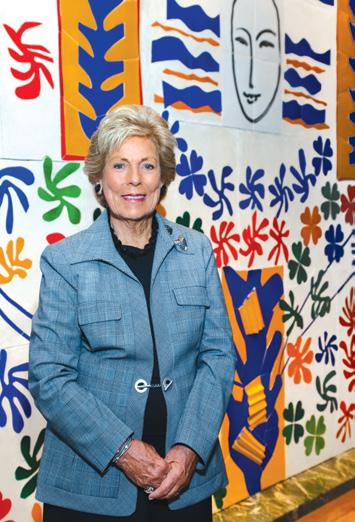
Since their very first purchase, The Georgia Welles Apollo Society has selected works of art that have helped strengthen and broaden the collection. This has become particularly apparent in the last few years as the Society has made several notable purchases of contemporary global art from geographic regions and cultures previously underrepresented in the collection, showcasing the work of artists with diverse perspectives and backgrounds, like South African artist Mary Sibande and Indian artist Ravinder Reddy (see pages 53 and 56). These recent additions to the collection are representative of the Museum’s continued efforts to connect to and reflect upon the broader global society of which we are all a part in the 21st century.
Membership in The Georgia Welles Apollo Society has grown significantly in the past five years as a new group of enthusiastic art lovers has joined long-time participants to contribute time, money, and votes toward the acquisition of art of great quality and importance. This is a tribute to Georgia’s stewardship and vision, her passion for great art, and her ability to inspire others. It is because of these qualities of hers that the future of The Georgia Welles Apollo Society is indeed bright. And I join her in heartily inviting one and all to consider joining the ranks, to find the same sense of wonder, discovery, and fulfilment as so many others have enjoyed through their involvement in this worthy endeavor. Your participation is needed and welcomed to maintain and grow the prestige of the Toledo Museum of Art locally, nationally, and internationally for the next thirty years and beyond.
Brian P. Kennedy President, Director, and CEO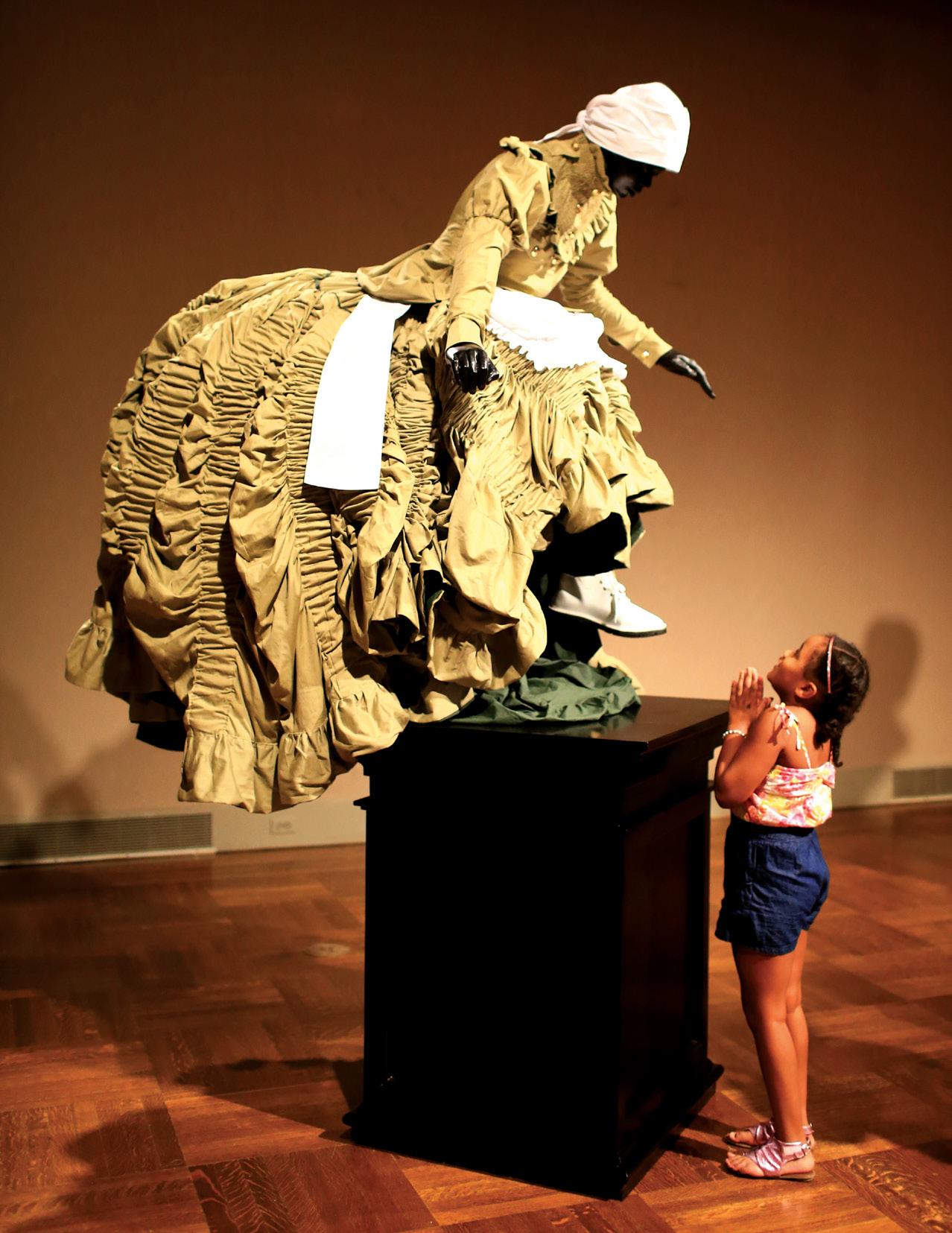
The decision to form a member group to support the Toledo Museum of Art’s outstanding collections came about in February 1986, when TMA Director Roger Mandle, Deputy Director Roger Berkowitz, and I met to discuss the idea. Our model was the Collectors Committee of the National Gallery of Art, Washington, which was established to foster the acquisition of large-scale modern and contemporary works for the recently built East Wing. Our primary objective was to enhance the Museum’s collection. We also wished to encourage members to begin their own art collections as their knowledge and enjoyment of art naturally grew through presentations by our
curators and special lectures by outside experts. Roger Berkowitz was tasked with drawing up an outline of the collecting group’s mission and The Apollo Society was born, taking its name from the beautiful Henri Matisse mural that greets us as we enter the lower lobby of the Museum (Figure 1).

From the beginning, we knew the program would need to embrace a larger collecting scope than the one adopted by the National Gallery. With the intention of considering as wide a range of art as possible, we began by asking the curators to present objects they wished to have added to the collection in the areas of paintings, drawings and prints,
antiquities, decorative arts, sculpture, and glass. Appropriately, antiquities was chosen as our first subject. The fascinating objects we were to choose from were described in effervescent detail by Kurt Luckner, the newly chosen Apollo Society curatorial liaison. Twenty-five members—some as couples, some as individuals—cast ballots and selected a glittering trove of Alexandrian gold as our first purchase choice (p. 11). Three of the other objects Kurt had presented were subsequently given to the Museum by members who could not bear to see them returned to the dealers (a situation that has repeated many times through the years). We couldn’t have asked for a better start!
Inspired by this early success, The Apollo Society, open to all who were Museum members at the President’s Council level, grew in size each year, expanding our buying power and enriching the collection with such diverse objects as a Han Dynasty cosmetic jar (p. 13), the gilded silver Richmond Race Cup of 1787 (p. 22), a commissioned glass and metal bench by Howard Ben Tré (p. 20), two 19th-century chandeliers (pages 32–33), and a three-channel video installation (p. 55). It has been more than gratifying to Apollo members when acquisitions add a new dimension to the collections, such as the Museum’s first Scandinavian painting (Interior of Courtyard, Strandgade 30 by Danish artist Vilhelm Hammershøi, p. 35); or become visitor favorites, like Chuck Close’s Alex (p. 12).

On occasion The Apollo Society has been involved in bringing works of art into the collection outside of its normal voting structure. In one remarkable example, the family of founding member Henry L. Thompson, Jr. gave funds in his memory to the Society with which to choose an outdoor sculpture for the collection. We selected Triple N Gyratory III by the wonderful kinetic sculptor George Rickey (Figure 2).

Along with the serious pleasure of learning about and choosing objects to give to the Toledo Museum of Art collection, Apollo members have enjoyed the camaraderie of dinners in every corner of the Museum, informative presentations by renowned art experts, field trips to distant places, an annual picnic, and some surprising revelations. (Figure 3). On one memorable occasion, a dealer, whose magnificent English chandelier we had just chosen, gave a magnum of
champagne to the member who could most correctly guess the number of cut glass pendants on the chandelier. The winner was the member who totaled the numbers of his wedding date. Thus, art is passion as well!
As The Apollo Society grew and developed, Roger Mandle was succeeded by David Steadman, who inspired the exhibition and catalogue celebrating The Apollo Society’s tenth anniversary. David Steadman was followed by Roger Berkowitz, Don Bacigalupi, and Brian Kennedy. They, along with Larry Nichols, the current curatorial liaison, who curated the exhibition and supervised the accompanying catalogue highlighting The Apollo Society’s twentyfifth anniversary in 2010, have all supported Apollo with strength and leadership, bringing us to this extraordinary moment where we now share with you in this book the 58 remarkable acquisitions made by The Apollo Society over its now thirty years of existence. The Apollo Society has also been ably supported over the years by the many individuals of the Museum staff—curators, development officers, librarians, registrars, and art handlers—who make the annual presentations possible. We will continue to work with them and with the Museum’s director, Brian Kennedy, as we look forward to another thirty years and more. The Apollo Society has been privileged to participate in the great legacy of giving established by Museum founders Edward Drummond Libbey and Florence Scott Libbey. It is my fervent hope that the same pride and joy in giving that we have experienced will be shared by the next generation of Apollo members.
1986/87
Gold, 375–325 bce
Gift of The Georgia Welles Apollo Society, 1987.3a–f
Greek gold jewelry of extraordinary craftsmanship was made in astonishing quantities during the later fourth century bce . The conquests of Philip II and his son Alexander the Great brought home gold in unprecedented amounts, and men and women decked themselves with jewels for festivals, processions, and banquets.
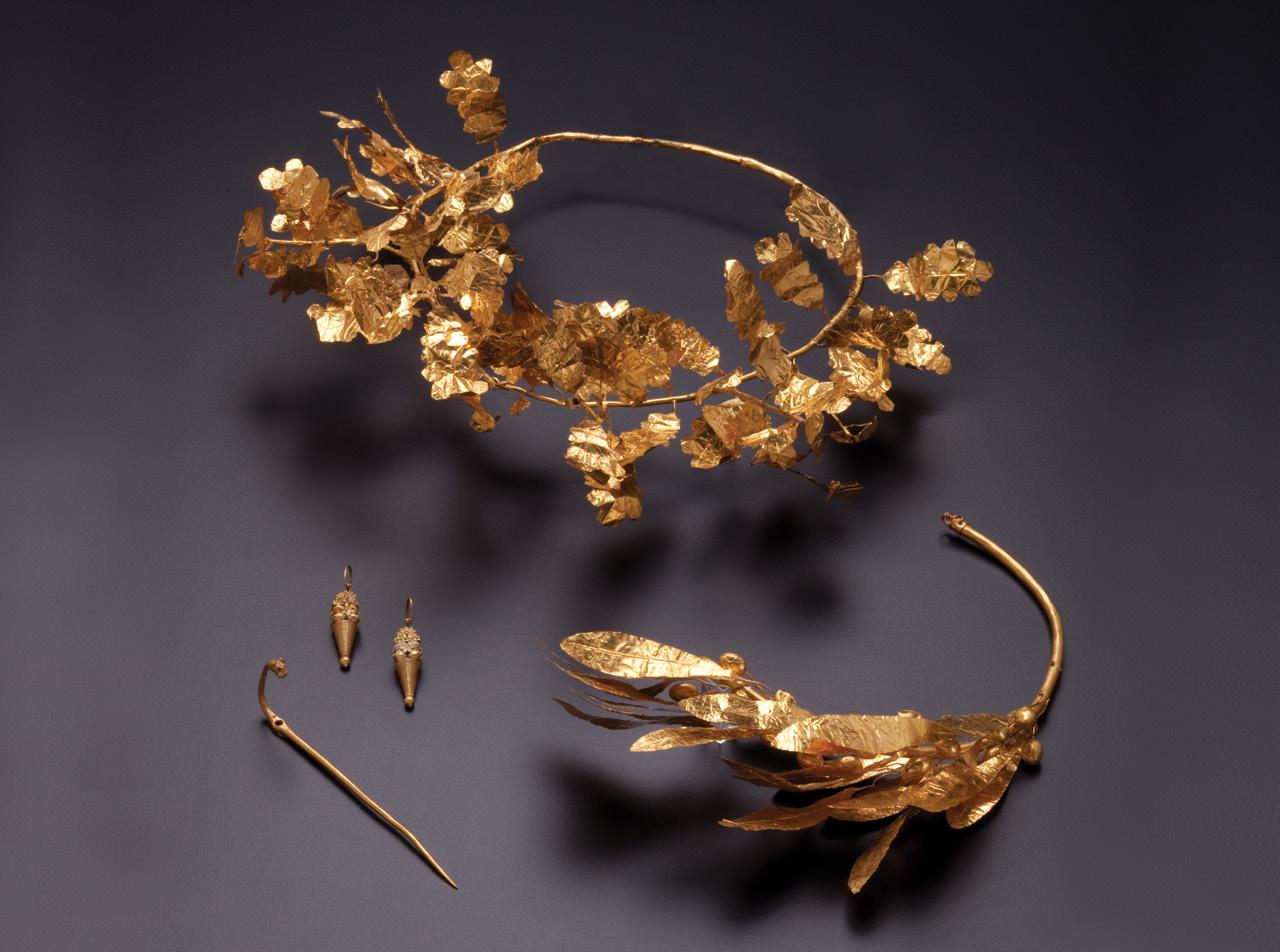
Imperishable gold wreaths imitating oak, olive, ivy, grape, laurel, and myrtle survive from the tombs and sanctuaries of Greek cities from the Black Sea to South Italy. The oak was the sacred tree of Zeus, king of the gods; the olive was sacred to Athena, patron of Athens.
Oak wreath, max. W. 121⁄4 in.; half olive wreath, max. W. 81⁄4 in.; earrings, H. 17⁄8 in.; pin, L. 43⁄4 in.
1987/88
American, born 1940
Alex
Oil on canvas, 1987
Gift of The Georgia Welles Apollo Society, 1987.218
© Chuck Close, courtesy PaceWildenstein, New York
Inspiring first awe and then intimate scrutiny, Chuck Close’s large-scale portraits draw attention to process as well as image. Working from photographs, Close imposes a grid—which is left visible—to enlarge and transfer the image onto canvas. Viewed from a distance, the thousands of small painted squares optically blend into an illusionistic portrait, but separate into ab-stract markings at close range. In Alex, artist Alex Katz’s unique features project an intense, almost aggressive, personality. However, since Close emphasizes factual, visual information and process, the painting’s emotion-al power is more a byproduct of the technique, monumental scale, and iconic frontality of the image than of any intended psychological interpretation.
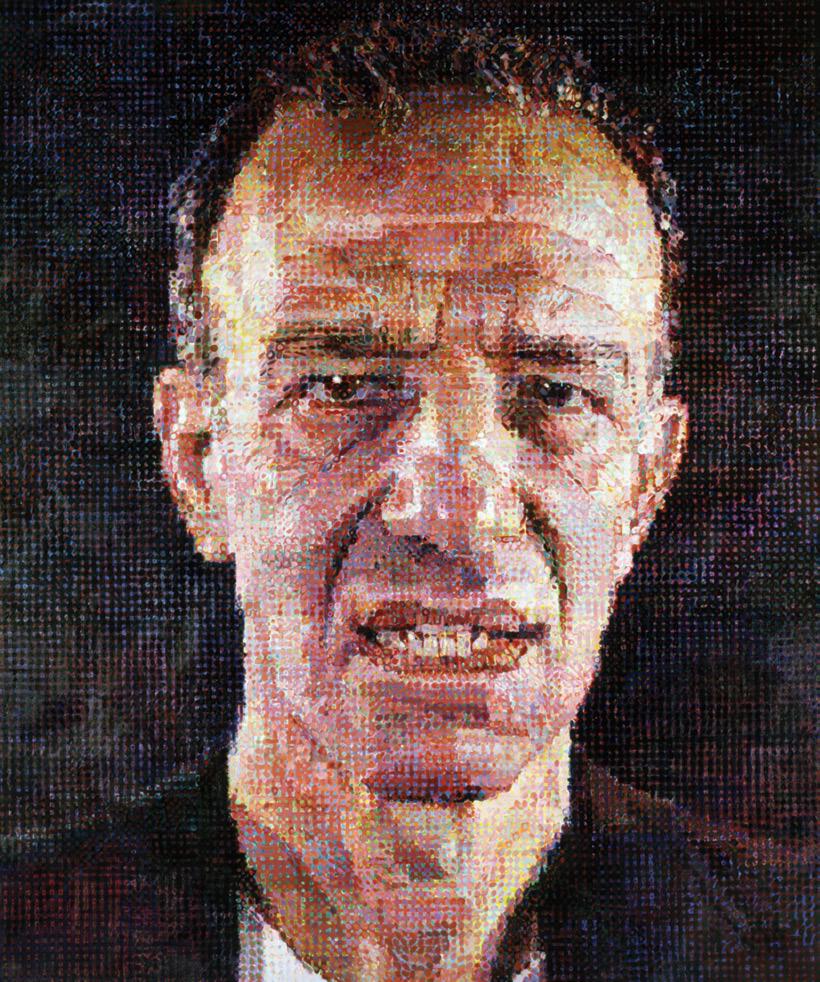
Han Dynasty, 207 bce–220 ce Cosmetic Container

Bronze with incised and applied decoration
first century bce–first century ce
Gift of The Georgia Welles Apollo Society, 1989.1
Modeled on earthly homes, Han dynasty tombs were created to provide lavish material comforts for the deceased. In some cases, so many burial objects were packed into the “house for the dead” that there was barely room for the coffin. This bronze cosmetic case is an example of a luxurious accessory that would have been placed in such a tomb. The bronze was cast in two pieces, with an incised crested phoenix indicating where the top and bottom fit together properly. The top of the convex lid features three solid bronze rams that surround a central lifting ring. All of the animals signify the transition from the material to the spiritual world.
1988/89
Gilded bronze with lapis lazuli and turquoise, 15th century Gift of The Georgia Welles Apollo Society, 1989.4
Though stylistically indebted to the art of India, this Tibetan gilt bronze image of Buddha is, like Tibetan Buddhist art in general, richer in detail and materials and smaller in scale. The Buddha sits in the lotus position, his left hand on his lap, palm facing up, in a position called the dhyana-mudra, a gesture of meditation. His right hand is in
the bhu-misparsamudra, in which Buddha extends his hand to touch the earth. The position represents when Buddha resisted the temptations of the demon Mara and called upon the Earth to witness his victory. Soon after this momentous event the Buddha was able to reach Enlightenment.

1989/90
American, born 1949
Untitled, #5 AND Untitled, #9
Charcoal on paper, 1989


Gift of The Georgia Welles Apollo Society, 1990.12, 1990.13
© Terry Winters / Courtesy Matthew Marks Gallery, New York
Terry Winters creates bold work that explores intensely personal and socially evocative imagery. These two drawings suggest biological cells. Drawn on a grand scale, Winters’ images of the basic unit of our physical make-up are nearly as large as we are. The inherent disorientation of scale evokes the quintessential late-twentieth-century
mixture of macrocosm and microcosm. Their implied reference to the underlying structure and organization of nature also sets up metaphors for organized social structures and social interactions, especially between man and woman. As abstract compositions, Winters’ drawings record a visceral interaction among artist, idea, and material; inspiration, gesture, and surface.
Untitled, #5, 301⁄4 x 221/2 in.
Untitled, #9, 301/8 x 221/2 in.
1989/90
Susan Rothenberg
American, born 1945
Untitled
Oil and charcoal on paper, 1989
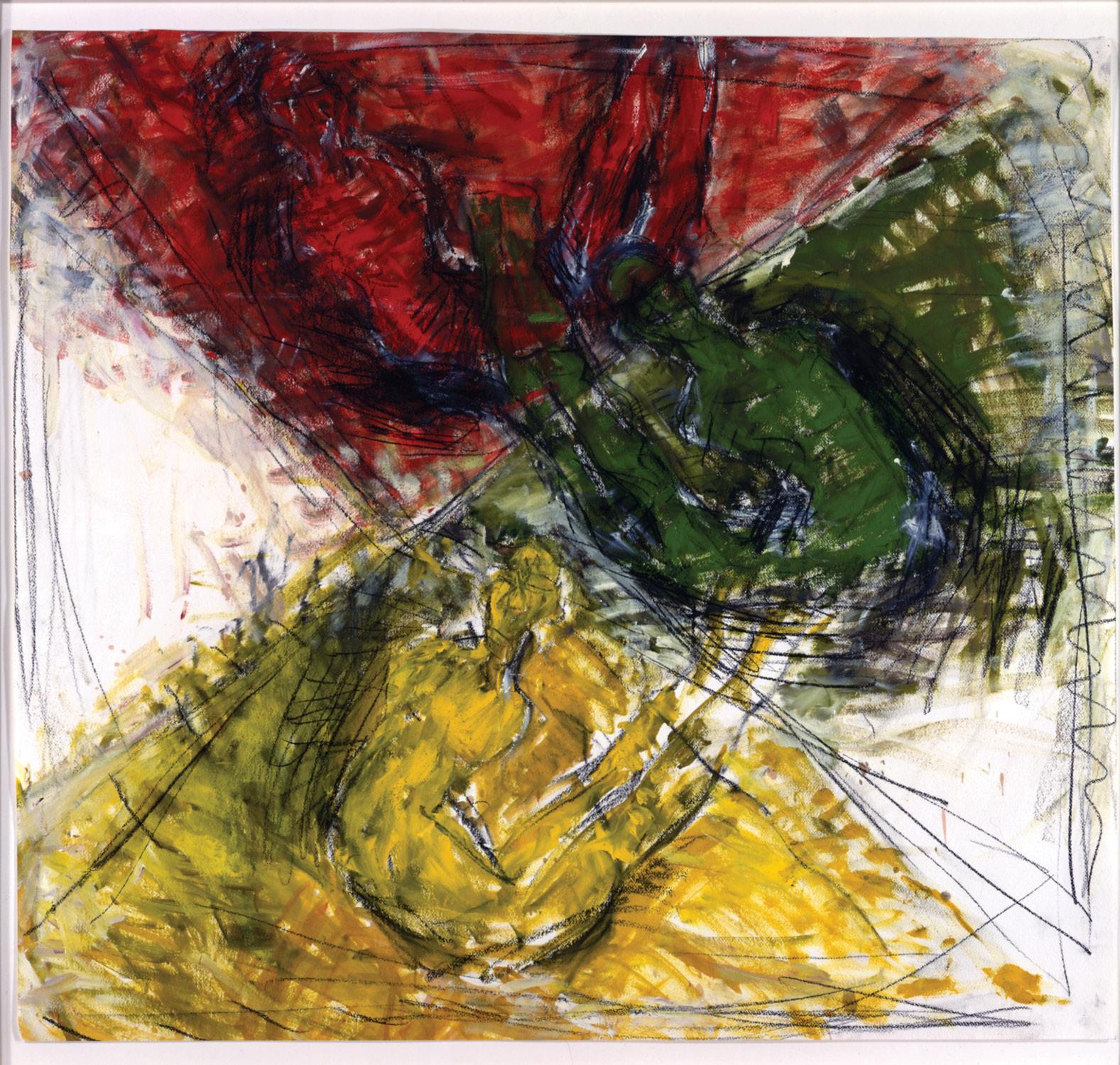
Gift of The Georgia Welles Apollo Society, 1990.6
© Susan Rothenberg / Artists Rights Society (ARS), New York
Combining expressive draftsmanship, tradition, and modernism, Susan Rothenberg conveys a sense of energetic motion. Her bright colors and use of light evoke her acknowledged debt to nineteenth-century Impressionist painters such as Claude Monet. Yet she strives for something expressive of contemporary life—an intellectual and visual dichotomy between movement and stasis, and a desire to capture our fast-paced life. The interest in motion (athletes, dancers, acrobats) seen in her earlier work here dissolves into pure energy, though there is still a suggestion of figures somersaulting and tumbling. Rothenberg’s dazzling brush strokes, bold line, and strong color enliven the surface, creating a visceral, kinetically charged image.
1989/90
Eric Fischl
American, born 1948
Untitled
Oil on paper, 1989
Gift of The Georgia Welles Apollo Society, 1990.5
Eric Fischl’s Untitled is a striking contemporary drawing about power and sexuality. Derived in part from a photograph taken in 1930 by George Platt Lynes in which a nude young woman stands spread-legged before a gray background, Fischl’s image depicts a full-length nude inexplicably standing in front of an automobile. Here the figure is juxtaposed with the archetypal machine of modern culture, one that is inextricably associated with the male gender. Her sexually assertive pose projects a power that seems to match that of the bold yellow-green car. Characteristic of Fischl’s work, the sensual qualities of the image are accentuated by the vibrant pastel colors and the painterly brush strokes applied like fingerpaints.

1990/91
Dale Chihuly
American, born 1947
Cadmium Orange Stem Form
Blown glass, 1989

Gift of The Georgia Welles Apollo Society, 1991.20a–n © Dale Chihuly
Dale Chihuly, a student of studio glass pioneer Harvey Littleton, has had a longstanding relationship with the Toledo Museum of Art through early studio glass exhibitions, commissions, and workshops. The Georgia Welles Apollo Society’s acquisition (with the assistance of the artist himself) of this important group of sculptural vessel forms allowed the Museum
to document the evolution of Chihuly’s career from 1975 to 1990, beginning with the Navajo Blanket Cylinders and Basket Sets The 1980s are represented by the evocative and colorful Seaforms, Macchia, and Persians series. The splendid example from the floral Venetians series, begun in 1988, was an exuberant preview of Chihuly’s work to come in the 1990s.
H. 135⁄8 in., L. 215⁄16 in. (largest piece)
Glass, 1986. Daim. 91⁄4 in. (largest)
Gift of The Georgia Welles Apollo Society and the artist, 1990.105a–xx © Dale Chihuly
Glass, 1982–84. H. 153⁄4 in. (largest)
Gift of The Georgia Welles Apollo Society and the artist, 1991.17a–e © Dale Chihuly
Glass, 1984. H. 12 in.
Gift of The Georgia Welles Apollo Society and the artist, 1991.18 © Dale Chihuly
Glass, 1984. L. 173⁄4 in. (largest)
Gift of The Georgia Welles Apollo Society and the artist, 1991.19a–d © Dale Chihuly
Glass, 1979. L. 143⁄4 in. (tray)
Gift of The Georgia Welles Apollo Society and the artist, 1991.16a–g © Dale Chihuly

Glass, 1990. H. 29 in.

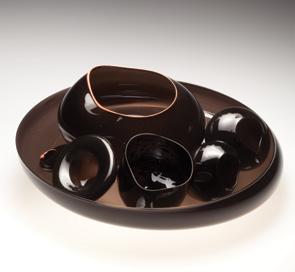


Gift of The Georgia Welles Apollo Society and the artist, 1991.21 © Dale Chihuly
 1.
3.
6.
5.
2.
4.
1.
3.
6.
5.
2.
4.
Patinated cast bronze and low expansion cast glass, gilding, 1992
Gift of The Georgia Welles Apollo Society, 1992.18a–b
© Howard Ben Tré
Sculptor Howard Ben Tré has chosen cast glass as his primary medium of artistic expression, using it to explore the merging of organic and geometric qualities in form and decoration. He is particularly drawn to sandcasting, a process that gives an aged feeling to contemporary shapes while preserving the formal sculptural dialog between interior and exterior. Ben Tré’s sculptures are suggestive of residual creations of an imagined civilization.
Commissioned by The Georgia Welles Apollo Society as gallery furniture, the two halfmoon benches can be reconfigured. The gift also included Ben Tré’s acrylic maquettes and working drawings for six proposed benches, all named for his late friend, the French glassmaker Claude Monod (1945–1990).

1991/92
France, Strasbourg
Tin-glazed earthenware painted in colors, 1749–60

Gift of The Georgia Welles Apollo Society, 1992.24a–c
The Paul Hannong manufactory in Strasbourg (1721–1784) specialized in tin-enameled faience. It became renowned for its new techniques and the quality of its painted decoration. This covered dish and stand are highlighted by a palette of colors known as petit-feu (“little fire”), or reflected colors. This technique was introduced into the Hannong
workshop around 1745. It was a new process that involved firing at a lower temperature, enabling a palette of colors to be produced which could not be obtained through firing at high temperature. Particularly characteristic is the introduction of pink, which was arrived at through mixing gold and pewter chloride (or “purple of Cassius”).
Silver-gilt, cast and chased, 1787
Gift of The Georgia Welles Apollo Society, 1992.25a–b
When the annual Gold Cup race for 4-yearold thoroughbreds was held on September 4, 1787 in Richmond, Yorkshire, it was a propitious day for Peregrine Wentworth, the owner of victorious racehorse Poor Soldier. Not only did the title establish his steed as a champion for breeding, but Wentworth also was awarded this monumental trophy cup, the weight of silver in which—125 ounces— represented the monetary value of his prize.
Prominent British goldsmith John Scofield created this masterpiece in restrained neoclassical style, characterized by geometric form and a sparing use of Greek and Roman ornament divided into decorative zones. Two shallow relief medallions feature race-related imagery, and a winged Victory holding a laurel wreath tops the trophy.
 H. 231/2 in.
H. 231/2 in.
Probably from Vulci in southern Etruria (central Italy)

Terracotta, bucchero ware, 550–525 bce
Gift of The Georgia Welles Apollo Society, 1993.51
The glossy dark material of this cup is called “bucchero” ware. Made of red clay, it is black all the way through because of the way it was kiln-fired in a smoky, oxygenpoor atmosphere. The color and shape are characteristically Etruscan but emulate blackglazed pottery made in Greece, which itself
imitated costly vessels made of metal, as can be seen from the thin handle, sharp ridges, and rivet-like knobs. The molded relief decoration on the handle—a frontal head of a woman and a profile figure of a man wearing a fringed tunic—and the incised zig-zag also resemble the decoration of metal vessels.

Wood with inlays of Egyptian blue and black pigment, about 1350 bce Gift of The Georgia Welles Apollo Society, 1993.52
The mummy, coffin, and funerary equipment of Henut-wedjebu, the “lady of the river banks, the singer of Amun,” were found in Luxor (ancient Thebes) in 1896 in a small, undecorated tomb alongside those of a man named Hatiay, possibly her husband, and two other women. Henut-wedjebu’s titles indicate that she was an upper-class woman. This large and beautifully carved shabti, or mummiform servant figure, was made to magically perform menial work, such as harvesting grain, in place of Henut-wedjebu in the afterlife. Elegantly carved from dark wood imported from central Africa, this shabti is inscribed with the customary animating text from chapter six of the Book of the Dead.

Molded terracotta with painted decoration, about 325–300 bce Gift of The Georgia Welles Apollo Society, 1993.63
The city of Tanagra gave its name to a type of charming fired clay statuette when thousands were excavated from its cemeteries during the 1870s. The heads, arms, and bodies were formed in molds and assembled, then handfinished to make each figurine unique with details like earrings, curls of hair, hats, and fans. The surface was coated with a thin layer of white slip and painted in bright colors. This “Tanagra” may represent a goddess, perhaps Aphrodite or Kore (Persephone), but is more likely a mortal worshipper. Her pose is elegant, her jewelry dainty, and her hair exquisitely coiffed, embodying Hellenistic ideals of grace and beauty.
American, born 1949
Sculpture No. 4
Bronze, designed 1991, cast 1994
Gift of The Georgia Welles Apollo Society, 1994.42 © Mel Kendrick
The dainty, dancing legs of Mel Kendrick’s Sculpture No. 4 support a complex, twisting cluster of forms that spirals inexorably upward until it bursts outward near the top. To make his “assembled” sculpture, Kendrick cuts wooden timbers with a chain saw and then fits and bolts the pieces together in his studio. During the 1980s, he began casting
some of his wood sculpture into bronze: “In some ways, my work in bronze clarifies what I’m doing because the bronze exaggerates the natural [qualities of wood], allowing an awareness of saw marks and wood grains.”
Designed in 1991, the wood version of Sculpture No. 4 was cast into bronze in 1994.

1994/95
Léon-Mathieu Cochereau
French, 1793–1817
The Interior of David’s Studio at the Collège des Quatre-Nations, Paris
Oil on canvas, 1814–17
Gift of The Georgia Welles Apollo Society, 1995.8
A pupil of Jacques-Louis David, the most important artist in France during the Revolution and succeeding Empire under Napoleon, Cochereau here represents his master’s studio in which a life drawing class is underway. The model at right is recognizable as “le polonais,” a Pole who posed for numerous academic studies at the time. David himself is not present. He was compelled to leave France in 1814 due to his anti-royalist sympathies after the Bourbon monarchy was restored to power. Instead Cochereau cleverly alludes to the presence of David with the unattended, shrouded canvas on the easel before the window.

1995/96
Roberst Arneson
American, 1930–1992
Laughing Vase
Glazed earthenware, 1974
Gift of The Georgia Welles Apollo Society, 1996.9
Made in 1974, before Robert Arneson was diagnosed with the cancer he battled for the rest of his life, Laughing Vase epitomizes the artist’s earthy sense of humor, zest for life, outstanding technical skill, and playful approach to painting with colorful ceramic glazes. Laughing Vase belongs to Arneson’s highly acclaimed series of self-portraits, on which he worked intermittently throughout his career. Eyes crinkled and every tuft of beard sprouting aggressively, the vase’s laughing face exudes all the energy of the artist’s own personality. The vase refers specifically to the long history of head-shaped vessels that began with the ancient Greeks.

Corten and stainless steel, 1995

Gift of The Georgia Welles Apollo Society, 1996.13
© Albert PaleyCommissioned specifically for the Museum, Continuum fuses, with pyrotechnical virtuosity, influences from the Museum’s ancient art collection, the original Museum building’s classicizing architecture, and the shifting geometric forms of the Frank O. Gehry-designed Center for the Visual Arts on the Museum’s campus. The primary reference is to the Doric columns that support the central lightwell of the Museum’s Classic Court, but there are also shapes reminiscent of the foot of an ancient Greek kylix (cup) and an Italic Villanovan razor. Trailing ribbons of Corten steel, Paley’s trademark, tumble gently around the column. “You have some formal elements and some casual ones, and these things are like a collage which is in motion,” Paley explains.
American, born Korea, 1938

Electroformed copper, silver plate, 1986
Gift of The Georgia Welles Apollo Society, 1996.10
© Chunghi Choo
Korean-born Chunghi Choo moved to the United States in 1961 to study metalsmithing, weaving, and ceramics at the Cranbrook Academy of Art in Bloomfield Hills, Michigan. Choo’s sculptural metalwork from the 1980s is inspired by traditional Asian calligraphy, but its execution is rooted in American craftsmanship and modern technology. In order to achieve the fluidity of form she envisioned, Choo developed an industrial electroforming process for studio use, building her vessels in copper on a wax model, then silver-plating them. The sweeping movements characteristic of the calligraphy brush have been transformed here into a three-dimensional, flowing, organic vessel shape, the graceful upward swing of the handles airily dismissive of their function.
1996/97
Sèvres Porcelain Manufactory
French, 1756–present
Pair of Vases with
Fables by Jean de La
Fontaine
Hard-paste porcelain, 1866
Gift of The Georgia Welles Apollo Society, 1997.256, 1997.257
The Japanese-influenced decoration on this pair of vessels from the Sèvres Porcelain Manufactory was drawn from two fables by Jean de La Fontaine (1621–1695), The Heron and The Frogs who Asked for a King The vases feature a special type of decoration known as pâte-sur-pâte (“paste on paste”). Introduced by Sèvres in 1849, it was developed by sculptor Léopold-Jules-Joseph
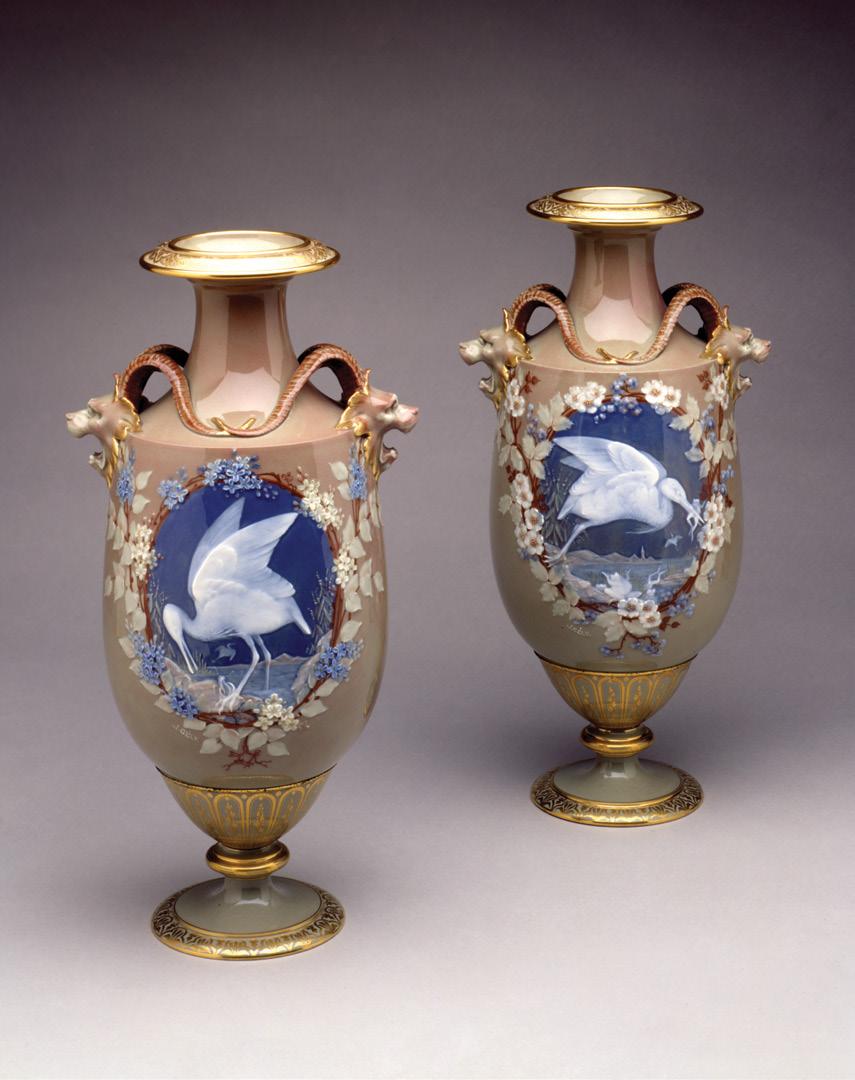
Gély (French, active 1850–1880). Successive layers of white slip (liquid clay) are applied with a brush, painstakingly building up figural and ornamental motifs in low relief. These vases were glazed with another innovative technique, pâte changeante or pâte caméléon, which causes them to change color from gray-green in natural light to a pinkish hue in artificial light.
H. 157⁄8 in. (each)
1997/98
British, active 1795–1935
Chandelier
Molded, cut and polished glass; silvered brass, 1850–60
Gift of The Georgia Welles Apollo Society, 1998.7
The most elegant and luxuriously appointed Georgian interiors were fitted with cut glass chandeliers and candelabra that were both functional light sources and decorative focal points. Chandeliers were prohibitively expensive to buy and maintain, so many households would simply hire them for parties, at a fee of about 10% of their value. London glass manufacturer Perry & Co., the primary
supplier in England for such lighting in the first half of the nineteenth century, satisfied the tastes of the most demanding clientele. The reflective and refractive properties of the flawless British cut glass of this classic example multiplied the flickering light of the chandelier’s twenty candles, providing a festive ambiance for any room of stately proportions.

1997/98
French Chandelier
Cast bronze, fire-gilded, malachite
veneer, 1830–45
Gift of The Georgia Welles Apollo Society, 1998.6
Many stylish French interiors were illuminated since the beginning of the nineteenth century by bronze fixtures for gas lighting, a novel new light source appreciated for its brightness and ease of use. The fixtures’ metal structure was eminently suited to the extensive heat generated by the gas flames. This substantial ceiling light or gasolier features a suspended crown of three-dozen lights on twenty-four
arms arms resembling cornucopias that are arranged in two tiers, accentuated by a horizontal ribbon of bright green malachite veneer. The design boldly references classical motifs such as acanthus leaves, palmettes, and vegetal scrolls. These details are finely chiseled and grained to lend the gasolier great vitality and visual variety when illuminated by its bright lights.

1998/99
Roberto
MattaChilean, 1911–2002
Oil on canvas, 1959
Gift of The Georgia Welles Apollo Society, 1999.5
© Artists Rights Society (ARS), New York / ADAGP, Paris
By the time he painted Gay Above All in 1959, Roberto Matta had left behind an earlier reliance on a landscape division of earth and sky, instead allowing an all-over composition that flows from section to section. The corners utilize a more subdued palette that gets brighter intermittently in swaths of yellow and spots of bright, flame-like oranges and reds.
The different shapes and colors are evocative of an unearthly landscape or of cosmic particles swirling in an imaginary galaxy. His “inscapes” as he called them feel alien and abstract, but also hauntingly familiar—they evoke a feeling that if you could just look closely enough, the image would suddenly resolve itself into a recognizable subject.

Vilhelm Hammershøi
Danish, 1864–1916
Oil on canvas, 1899
Gift of The Georgia Welles Apollo Society, 2000.30
Vilhelm Hammershøi, a city dweller his entire life, moved to an old merchant house at Strandgade 30 in Copenhagen, Denmark, in December 1898. For the decade that he resided there in a second-floor apartment the artist painted more than sixty canvases depicting the rooms of the dwelling, often including his wife, Ida. Influenced by Dutch seventeenthcentury painting, particularly that of Vermeer and Pieter de Hooch, Hammershøi’s meditations on the interior spaces in his apartment are psychologically enigmatic. Here the painter renders the structure’s interior courtyard with strong light falling on an open window, introducing the suggestion of human presence into a composition of strange colors and eccentric geometries.

Edward
SteichenAmerican, 1879–1973
Isadora Duncan in the Parthenon, Athens
Gelatin-silver chloro-bromide print, 1921
Gift of The Georgia Welles Apollo Society, 2002.13
© Edward Steichen
In 1921, standing in the portico of the Parthenon in Athens, the famed dancer Isadora Duncan (1877–1927) produced a poetic gesture mimicking the classical architecture surrounding her. Taking her picture, Edward Steichen fixed the poetry of her pose onto paper. Isadora Duncan in the Parthenon is one of the masterworks of Pictorialism and beautifully exemplifies the last moments of Steichen’s Pictorialist period. The application of the principles of painting to photography, Pictorialism was purposeful in evoking an emotional response from the viewer. Steichen, through Pictorialism, was one of the first artists to elevate photography into the great art form it is recognized as today.

American, 1823–1900
Bonchurch, Isle of Wight
Oil on canvas, 1859
Gift of The Georgia Welles Apollo Society, 2004.20
In the years 1856–63, Hudson River School painter Jasper F. Cropsey took up residence in London. During the late summer of 1859 he visited the Isle of Wight off the southern coast of England. There, in a style characterized by crystalline clarity of detail, he painted this scene of the small village of Bonchurch. A mother and her children taking in the serenity and splendor of nature are the focal point of the composition. A London Times review discussing the Royal Academy exhibition of 1860, in which this picture was thought to have been shown, praised Cropsey’s views of Bonchurch, “for their simple truth to nature...and affection [for] the homeliest beauties of English landscape.”


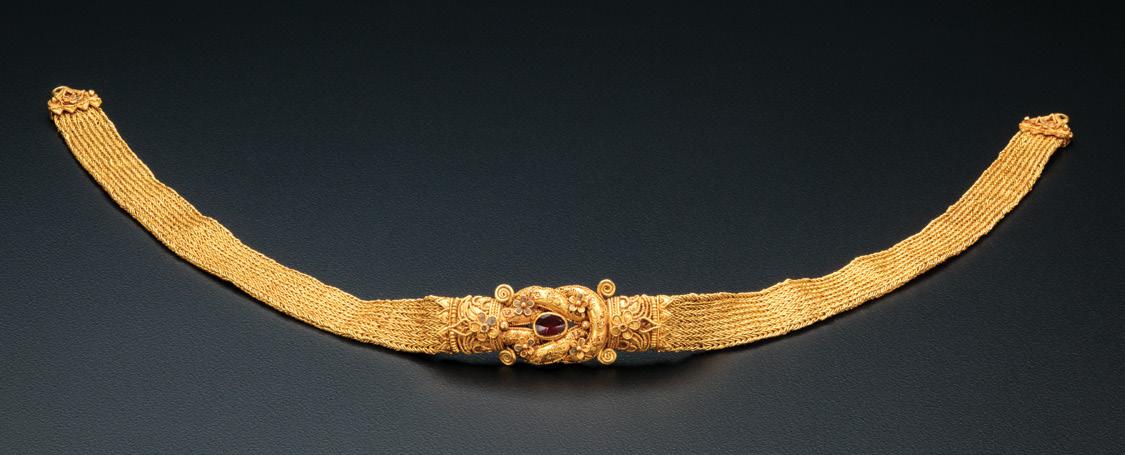
Gold, garnet, and blue glass enamel inlay, 250–150 bce
Gift of The Georgia Welles Apollo Society, 2005.45
A square knot is the central ornament of this exquisite diadem. Well known to farmers and sailors, the knot encourages trust—the harder it is pulled, the stronger it becomes. The ancient Greeks called it the “Herakles knot,” because the mythical hero Herakles used it to fasten a lion’s pelt around his shoulders. The knot in any form was a protective amulet. This diadem may have been a bridal gift: the blue flowers represent myrtle, sacred to Aphrodite, goddess of love, and also to Hera, goddess of marriage. Another possibility is that the diadem was a funeral gift for a woman who died before marriage.
Bernard Perrot
French, 1640–1709
Royal glasshouse, Orléans
Glass Medallion with A
Portrait of Louis XIV
Glass, mold-cast, ground, and polished, gilded and silvered; carved, gessoed and gilded wood frame, about 1685–1700

Gift of The Georgia Welles Apollo Society, 2006.42
The Italian immigrant glassmaker Bernard Perrot, founder of the royal glasshouse in the duchy of Orléans, contributed many important innovations to the manufacture of glass. He revised the casting of large plate glass for windows and mirrors, developed a translucent white glass imitating Chinese porcelain, and rediscovered the ancient process for ruby red glass. This medallion, one of the largest pieces of glass made in the seventeenth century, was created by a secret method of mold-casting glass reliefs. It is one of seven such Perrot medallions known today that were impressed with the image of the Sun King Louis XIV (ruled 1643–1715), and it retains its original carved and gilded wood frame.
Frame: 17 x 141/2 in.
Lynda Benglis

American, born 1941
Migrating Pedmarks
Bronze with patina, designed 1998, cast 2008
Gift of The Georgia Welles Apollo Society in honor of Georgia and David K. Welles, 2008.108
© Lynda Benglis / Licensed by VAGA, New York, NY
Working to balance abstraction and content, gesture, and mass, Lynda Benglis takes the painterly gesture of the Abstract Expressionists and translates it into three dimensions. To create this sculpture she started with rectangles of clay, which she twisted, pierced, and marked in a variety of ways, then assembled into one form. The resulting shape feels vaguely anthropomorphic and strangely sensual—a duality that is both a result of her process and of the evocative nature of the final form. The mark of the artist’s hand is literally embedded in the clay through her fingerprints. These potentially fleeting gestures are made permanent when the clay shape is cast in bronze.
2007/2008

Hinoki wood with lacquer paste and traces of gilding, about 1250–1300
Gift of The Georgia Welles Apollo Society, 2008.118
Bishamonten is the Japanese Guardian of the North (one of the four guardians that protect each of the cardinal directions) and as such, he would have been made to stand watch at the north corner of a Buddhist temple altar to ward off evil. He possesses several other aspects: guardian of Buddhist law, god of victory in war, and god of wealth and fortune. This provincial image of Bishamonten is typical—his left hand is raised to hold a small pagoda, symbolic of a treasure house, and his right arm is raised to hold a spear (both now missing), while the demon mask at his waist denotes the subjugation of evil.
H. 73 in.Paul Colin
French, 1892–1985
Portfolio of 44 lithographs, most with pochoir color, plus title page and introduction by Josephine Baker, 1927
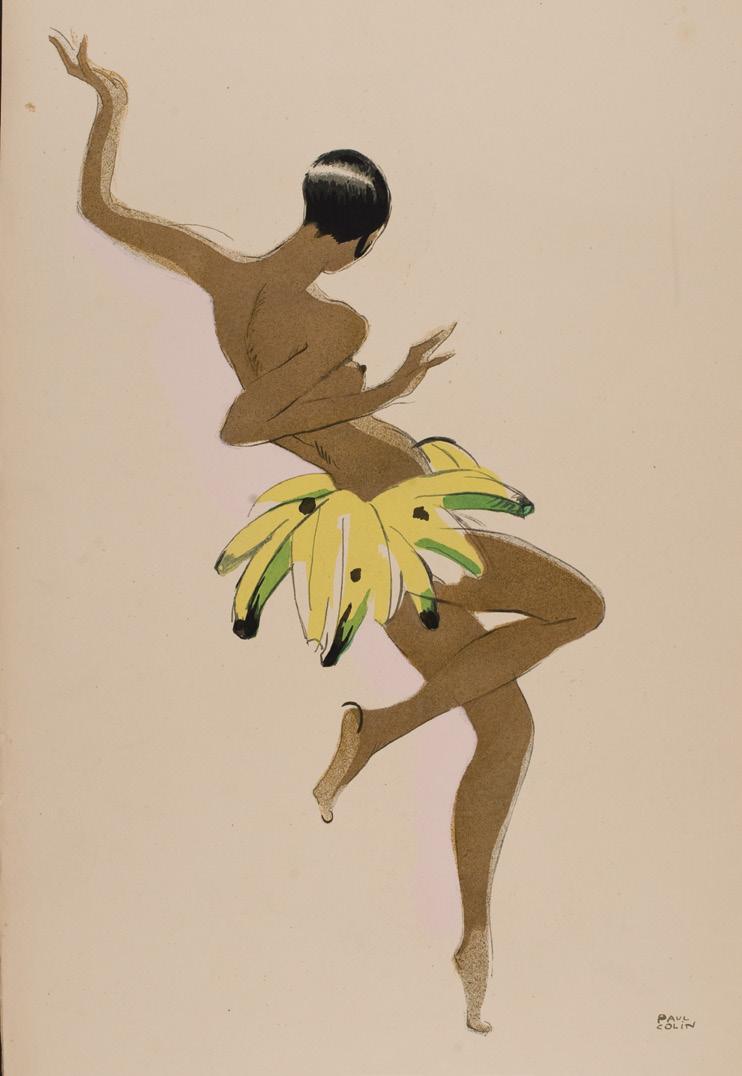
Gift of The Georgia Welles Apollo Society, 2009.24
© Estate of Paul Colin / Artists Rights Soceity (ARS), New York / ADAGP, Paris
In 1925, American Josephine Baker, or “La Baker” as she became known in France, took the stage at Paris’s Théâtre des ChampsÉlysées as if driven by a tornado. Sexy and modern, Baker (1906–1975) epitomized the Jazz Age. With her troupe of African American musicians and performers, La Revue Nègre, she introduced Paris to a new and exuberant dance called the Charleston. Inspired by the exotic spectacle, French poster artist Paul Colin created the stylish Art Deco portfolio, Le tumulte noir. Baker’s image is featured in two of the most recognizable prints: in one she wears only a skirt of palm leaves, and in another, she wears the famous skirt of bananas introduced at the Folies-Bergères music hall in 1926.
20 x 13 in.
Grayson Perry
British, born 1960
Print for a Politician
Etching from three plates on one sheet, 2005


Gift of The Georgia Welles Apollo Society, 2009.27
© Grayson Perry and The Paragon Press, London
Created by the Turner Prize-winning artist Grayson Perry, Print for a Politician is a veritable compendium of politics and culture transformed, by etching, into a map of juxtaposed similarities and differences. Perry began work on his provocative etching by first compiling a long list of names of cultural, political, and religious factions from around the world. He then randomly assigned a place for each in the extensive landscape. Inspired by aerial views of Venice and by Chinese scroll paintings, Perry created a print with astonishingly minute, and sometimes shocking, detail, impossible to take in with just one viewing—and designed to reveal that, “in the end, we are all just as bad as each other.”
263⁄4 x 981⁄4 in.
Zeng Xiaojun
Chinese, born 1954
Qing Qi Gu Guai
(Clear, Wondrous, Ancient, Strange)
Ink and color on paper, 1989
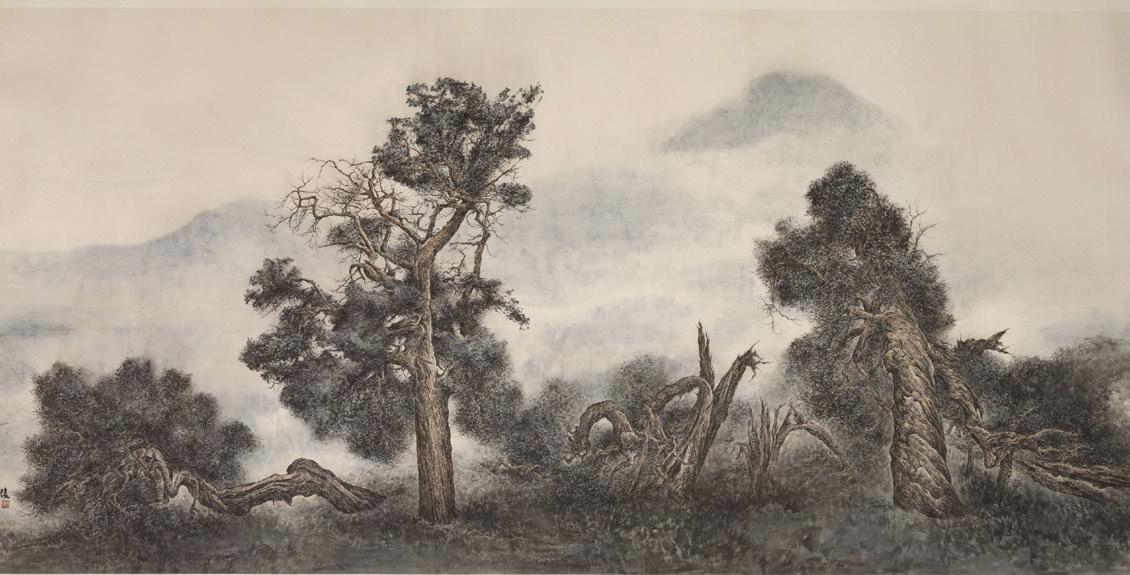
Gift of The Georgia Welles Apollo Society, 2009.63
© Zeng Xiaojun
More than eleven feet long and taking three years to complete, Qing Qi Gu Guai (Clear, Wondrous, Ancient, Strange) is a magical, meticulously drawn image of four tenacious, two-thousand-yearold cypress trees growing at the foot of Dengwei Mountain in Suzhou, a city often referred to as the “Chinese Venice.” Long admired and venerated, the four cypresses have inspired numerous poets and artists with their gnarled trunks and wild foliage. They are symbols of a passion for life and embody determination and survival. In this monumental drawing, Zeng Xiaojun, one of the best-known and most important ink painters in China today, has captured that determination with skill and breathtaking beauty.
2008/2009
Ann Hamilton
American, born 1956
legend
Lithography on Gampi tissue mounted to cloth.

Printed at Gemini G.E.L., 2007
Gift of The Georgia Welles Apollo Society, 2009.26
legend © Ann Hamilton and Gemini G.E.L. LLC
Ann Hamilton’s way of seeing into and through something and her practice of deconstructing it to expose basic forms led to the creation of legend . Destroying a piece of organza by pulling apart its structure, allowing the spaces to come forward from among the threads, the artist created ‘windows’ that break through the fabric shell. Hamilton explains, “I came to understand the distension of the cloth’s grid as a way of drawing. [At Gemini G.E.L.] we exposed the distressed cloth onto litho plates…I saw something when printed that I had not seen with the cloth in front of me. … As both a field and a pattern of individual threads, the image came forward into printmaking… .”
84 x 96 in.
Andrea Palladio
Italian, 1508–1580
Book with wood engravings and letterpress text, 1570
Gift of The Georgia Welles Apollo Society, 2009.25
In 2009 The Georgia Welles Apollo Society acquired for the Museum a seminal treatise that had been coveted by the Museum’s first director, George W. Stevens: Andrea Palladio’s Four Books of Architecture. Palladio was, and remains, the most influential architect in Western history, inspiring the redesign of London after the great fire of 1666 and much Colonial American architecture, including Thomas Jefferson’s Monticello. The Four Books codified theories of proportion and design that Palladio developed, in part, through the study of the classical architecture of Rome. The spectacular illustrations that appear on almost every page were recognized immediately as the work of a master and they, along with Palladio’s concise text, made the book an invaluable, and enduring resource.

Achille Etna Michallon
French, 1796–1822
Landscape Near Cava

Oil on paper on canvas, about 1820
Gift of The Georgia Welles Apollo Society, 2010.30
Achille Michallon, the son of sculptor Claude Michallon, grew up in the Louvre where his parents had an apartment adjacent to his father’s studio. Trained as a painter, in 1817 he exhibited two works at the Salon that earned him the very first prix de Rome established for historical landscape. His Landscape Near Cava was painted during his 1818 to 1821 stay in Italy. It records the locale near Cava de Tirreni, situated between Naples and Salerno. The picturesque town was a stopping-off place for artists traveling down the Italian coast. Michallon’s painting is a direct response to Nature as experienced by the artist, its dramatic vista an exploration of perspective and color gradation.
Lalla Essaydi
Moroccan, born 1956
Women of Morocco: The Grande
Odalisque (Les Femmes du Maroc:

La Grande Odalisque)
Chromogenic print mounted to aluminum and protected with Mactac luster laminate, 2008
Gift of The Georgia Welles Apollo Society, 2011.8
© Lalla Essaydi
In my art, I wish to present myself through multiple lenses—as artist, as Moroccan…as traditionalist, as Liberal, as Muslim. In short, I invite viewers to resist stereotypes.
Moroccan artist Lalla Essaydi’s series of photographs Les Femmes du Maroc (“Women of Morocco”) responds to the West’s perception of Muslim women through the lens of 19th-century Orientalism, in which European artists treated Near Eastern and North African cultures as colorful, exotic, and sensual. Muslim women are presented as sexually passive members of harems in images such as Ingres’s La Grande Odalisque (1814), from which Essaydi took the pose for Toledo’s photograph.
Essaydi’s “Grande Odalisque” (concubine) is draped in white mourning fabric rather than nude, and her gaze is more suspicious than inviting. Every surface, including her skin, is scrawled with Arabic calligraphy in henna—excerpts of musings on personal freedom, identity, and memory from Essaydi’s own journals. Essaydi’s use of calligraphy—a religiously charged Islamic art form typically reserved for men—creates a powerful statement as the silent woman is clad in words and thoughts that her society traditionally does not permit her to express.
2010/2011
African Tabwa people, Ujiji Region (modern United Republic of Tanzania)
Wood, pigment, fiber, and metal, before 1880
Gift of The Georigia Welles Apollo Society, 2011.12
Tabwa peoples trace their ancestors through the mother’s family lines, and ancestor figures, called mikisi , were kept in small shrines. Shrine sculptures of men and women were individually depicted, so this figure must have represented a specific mother and her child.

Both the mother and child display scarification—decorative and symbolic patterns deliberately cut into the skin. The child’s appear to be a continuation of the mother’s markings (young children were not in reality given scarification). The scarification on the mother emphasizes the importance of the navel, which represents the beginning of life and symbols of origin. The placement of the mother’s hands on her stomach symbolizes the family line as she keeps watch over her descendants.

Maya Lin

American, born 1959
Dew Point 18
Mold-shaped glass, cut and polished under base, 2007
Gift of The Georgia Welles Apollo Society, 2012.9a–r
© Maya Lin Studio, courtesy Pace Gallery
Exploring glass as a metaphor for water, Ohio native Maya Lin exploits the ability of glass to suggest the appearance of liquid in her installation Dew Point 18. The dew point is the temperature below which the water vapor in a volume of humid air at a constant barometric pressure will condense into liquid water. Surface tension of condensed water is responsible for the shape of the liquid droplets we call dew.
Most famous for her powerful Vietnam Veterans Memorial Wall in Washington, D.C.. Lin is an architect and artist known for her work in sculpture and landscape art. Her focus is on the emotions a space evokes and what her work can symbolize to those who experience it.
H. 3 in., W. 15 in.,
Depth: 15 in. (largest piece)
Glass, blown; sterling silver; video monitor; LED lights, 2012

Gift of The Georgia Welles Apollo Society, 2012.10
© Andrew Erdos
In Twilight Powered by Electricity , Andrew Erdos has created a multimedia reflective environmental work that beckons the viewer to become part of the piece. By looking closely and examining the work from all angles, you may discover a newly imagined world in which fantasy creatures float into and out of the mirrored walls. Erdos’ single animal becomes a virtual herd
of characters that are at once futuristic and nostalgic, slick and sensual, and charming and playful. Erdos says, “I like taking objects that we are comfortable with, like a human’s reaction to animals, and exploring how we interact with them. In my work, there is a complex series of relationships happening; I am trying to explore all the possible caveats of an idea.”
2011/2012
Jun Kaneko
Japanese, active United States, born 1942
Kilnformed glass, 2007
Gift of The Georigia Welles Apollo Society, 2012.20a–h
© Jun Kaneko
Conceptually a minimalist, artist Jun Kaneko responded intuitively to the translucent qualities of glass when creating this installation of geometric forms. This piece was created at Bullseye Glass Connection in Portland, Oregon where Kaneko challenged the facilities' technical capabilities by layering thin sheets of colored glass in visual sequences then fusing the stacks by kiln firing them. He also created detailed preliminary drawings which allowed him to deconstruct and strip complex visual language in order to communicate the roots of an arcane language of marks and colors. With controlled exuberance the Colorbox series conveys a restrained aesthetic:

The challenge of making successful work is to create art that strongly engages the viewer’s imagination in any environmental circumstance in which it is placed and experienced. Nothing exists by itself. Everything exists with the balance or imbalance of its relationship to others. This may be one of my central concerns and interests when creating any work.
H. 84 in.,
W. 1065⁄8 in.,
Depth: 83/8 in.
Installation: cast resin, fiberglass, cotton, tulle, and rubber, 2011

Gift of The Georgia Welles Apollo Society, 2013.160
© Mary Sibande, courtesy Gallery Momo
In her work Mary Sibande investigates issues of race, class, and power in postApartheid South Africa. Rubber Soul is the last in a series depicting Sibande’s semiautobiographical character Sophie, a South African maid. Sophie tends to appear as a matte black mannequin with her eyes closed, dressed seemingly both as a maid and a Victorian madam. This ambiguity of costume is a way for Sibande to question the overly simplistic dichotomies of servant versus mistress and black versus white, while asserting the power of fantasy and self-fashioned identity.
The khaki fabric and brass buttons of Sophie’s dress are associated with the characteristic suits of male members of the South African Zionist Christian Church, as are the white, rubber-soled shoes and Sophie’s jumping action, part of male churchgoers’ praise rituals. By wearing these clothes and engaging in this forbidden activity, Sophie is directly and powerfully challenging gender norms.
Mannequin, Dutch wax-printed cotton textile, fiberglass, globe head, steel base plate, leather suitcases, 2012
Gift of The Georgia Welles Apollo Society, 2013.32
© Yinka Shonibare
Born in London to Nigerian parents, Yinka Shonibare explores through parody and irony questions of identity, social hierarchy, and the colonization of Africa. Bent over, struggling to move forward, this Homeless Child of ambiguous race carries the last of his possessions. His head is a globe inscribed with an excerpt from Dickens’ Oliver Twist: “Bleak, dark, and piercing cold, it was a night for the well-housed and fed to draw round the bright fire, and thank God they were at home; and for the homeless starving wretch to lay him down and die. Many hunger-worn outcasts close their eyes in our bare streets at such times, who, let their crimes have been what they may, can hardly open them in a more bitter world.”
Despite the colonial costume, the figure addresses dislocation and poverty throughout history as well as during the current refugee crisis.
H. 1061/16 in., W. 253/16 in., Depth: 391/8 in.
Takashi Ishida
Japanese, born 1972
3-channel HD video with sound, 2007
Gift of The Georgia Welles Apollo Society, 2013.41
© Takashi Ishida
In Wall of Sea , three videos are projected simultaneously to reveal images of the sea and Ishida’s various points of progress in painting an image of the sea on the wall and floor of a gallery. Ishida presents his progress on the painting non-linearly and through stop-motion animation (an arduous process where every small movement is individually photographed). He removes the limitations of traditional film by having his work literally “flowing outside of its framework— collapsing the boundaries between film,

painting, performance, and sculpture as the moving image is realized in space.” The characteristic clicking and whirring sound of an old-school projector further emphasizes both the literal wall of the gallery on which the images are projected and the projected “wall of sea.”
Ishida’s Wall of Sea offers an exceptionally intimate and captivating work that allows the audience to observe his process without any obstructions.
Indian, born 1956
Painted and gilded fiberglass, 2003
Gift of The Georgia Welles Apollo Society, 2014.20
© Ravinder Reddy
With his fusion of contemporary pop art and Hindu sculptural tradition, Reddy creates a union of the ideal goddess and the individual woman. The frontality of the head and its wide, staring eyes evoke a timelessness similar to ancient sculpture.

New York Times art critic Holland Cotter said in a review of Indian artist Ravinder Reddy’s first solo show in New York, “The spirelike roofs of certain Hindu temples in South India are a dizzying pileup of hundreds of brightly painted carved figures. Most are of deities, but the ever-changing mix can also include politicians, movie idols and even an occasional Westerner of local renown. This blending of religion and pop culture is a constant in Indian art, and it is the impetus behind the work of Ravinder Reddy. His painted and gilded fiberglass sculptures of women have been among of the most visible examples of contemporary South Asian art since they first made a splash… in 1996.”
H. 44 in.,
W. 24 in.,
Depth: 42 in.
Gertrude Käsebier

American, 1852–1934
Portrait (Miss N.), from Camera Work
no. 1
Photogravure, 1903
Gift of The Georgia Welles Apollo Society, 2015.12a
Various artists
Published by Alfred Stieglitz
(American, 1864–1946)
Camera Work
Photogravures, photomechanical reproductions, and letterpress, 1903–17
Complete run (50 issues), plus the Steichen Supplement and Special Edition (a total of 473 photographs)
Gift of The Georgia Welles Apollo Society, 2015.12a–xx
Camera Work was a quarterly photographic journal published by Alfred Stieglitz from 1903 to 1917. It is known for its many high-quality photogravures by some of the most talented photographers of the day, including David Octavius Hill, Gertrude Käsebier, Edward Steichen, Stieglitz, Paul Strand, and Clarence White. The journal’s editorial purpose was to establish photography as a fine art at a time when it was more valued for its documentary, rather than aesthetic and artistic, possibilities.
Camera Work has been called “consummately intellectual” (Andrew Roth, Book of 101 Books: Seminal Photographic Books of the Twentieth Century); “by far the most beautiful of all photographic magazines” (Richard Whelan, Alfred Stieglitz: A Biography); and “a portrait of an age [in which] the artistic sensibility of the nineteenth century was transformed into the artistic awareness of the present day” (Jonathan Green, Camera Work: A Critical Anthology).
Marble, late 1st–early 2nd century ce
Gift of The Georgia Welles Apollo Society, 2016.19
This sculpted bust depicts an older woman, a matron, gazing off towards her right. The relatively advanced age of the woman is rare for this type of portrait, which can be dated on the basis of the hairstyle. Ornate, corkscrew curls were fashionable for women of the imperial court during the Flavian Dynasty (68–96 CE). The hairstyle is that of a much younger woman than depicted here. Perhaps the matron, whose identity is lost to us, wore her hair as a young person, or perhaps her family intended to remember her ‘young spirit’. The sculpture was intended to be placed in a family shrine, known as a columbarium, where each year on the anniversary of the matron’s death, her family would have rubbed palm oil on her cheeks. This ritual explains the yellowing still present on the sculpture.
The ability to render the elaborate coiffure in stone was enabled by the development of the running drill, a tool that allowed sculptors to create deep, precise holes with significantly less effort than before. The bust is therefore both a marvel of technology and, in its subtle rendering of the woman’s highly individualized features, of Roman artistic virtuosity.

Note: Some of the text for the catalogue portion of Inspired Giving. The Georgia Welles Apollo Society. 30th Anniversary. 1986-2016 has been adapted from the previously published Toledo Museum of Art books Toledo Treasures: Selections from The Toledo Museum of Art (1995), A Decade of Giving: The Apollo Society (1996), Toledo Museum of Art Masterworks (2009), and Inspired Giving: The Apollo Society's Twenty-fifth Anniversary (2010). Authors no longer at the Toledo Museum of Art whose words are herein adapted are cited below with an asterisk (*) next to their names.
Amy Gilman, pp. 12, 34, 40, 53, 54, 55
*Elaine D. Gustafson, p. 12
*Sandra E. Knudsen, pp. 11, 23–26, 28, 29, 38, 48, 49
Adam Levine, p. 58
*Thomas Loeffler, pp. 36, 42–46, 57
Lawrence W. Nichols, pp. 27, 35, 37, 47
Jutta-Annette Page, pp. 18–22, 30–33, 39, 50–52
*Robert F. Phillips, p. 29
*Carolyn M. Putney, pp. 13, 14, 41, 56
Paula Reich, pp. 15–17, 26
*Christine Swenson, pp. 15–17
*Davira S. Taragin, p. 20, 28
© 2016 The Toledo Museum of Art
2445 Monroe Street
P.O. Box 1013
Toledo, Ohio USA 43697–1013 www.toledomuseum.org
In addition to the thanks owed the various contributors to this book acknowledged elsewhere, gratitude for their help with this and previous Georgia Welles Apollo Society publications is extended to the following people. Staff members no longer at the Museum are cited with an asterisk (*) next to their names.
Todd Ahrens
Maureen Anderson
*Rod A. Bigelow
Andrea M. Gardner
*Toni Marie Gonzalez
Suzanne Hargrove
Julia Hayes
Brian P. Kennedy
Julie McMaster
*Tim Motz
Halona Norton-Westbrook
*Susan Palmer
Corinne Sheppard
*Allison Shriver
Elizabeth Spencer
*Patricia J. Whitesides
The Georgia Welles Apollo Society Curatorial Liaison: Lawrence W. Nichols
Managing Editor: Paula Reich
Designer: Jameson Staneluis
Front cover: Greek, Hellenistic period (about 323–31 BCE), Oak Wreath. Gold, about 360–325 BCE. Gift of The Georgia Welles Apollo Society, 1987.3a–f. Photo by Richard P. Goodbody.
Back cover: Roman, Bust of a Flavian Matron. Marble, late 1st–early 2nd century CE. Gift of The Georgia Welles Apollo Society, 2016.19. Photo by Richard P. Goodbody.
Photography: The China Porcelain Company, New York, NY, p. 44; Gemini G.E.L. at Joni Moisant Weyl, p. 45; Richard P. Goodbody, New York, pp. 9 (top), 11, 13, 14, 18, 19 (images 2 and 5), 20, 21, 23, 26, 29, 35, 38, 41, 46, 48, 49, 50, 51, 52, 53, 54, 56, 58; Image Source, Toledo, p. 27; Luettke Studio (Kristen Luettke), Holland, OH, p. 6; John F. Morgan, p. 39; Photography, Incorporated, Toledo, pp. 16, 22, 34; SFC Graphics, Toledo, p. 43; Andrew Weber, Toledo, p. 9 (bottom); Tim Thayer, Oak Park, MI, pp. 8, 19 (images 3, 4, and 6), 24, 25, 28, 30, 31, 32, 33; THREAD, Toledo, p. 36; Toledo Museum of Art, pp. 15, 40, 42, 47, 57; Andrew Weber, p. 7; Zindman/Fremont, p. 17
Composition: Adobe Garamond Titling, Adobe Garamon Semibold, Adobe Garamond Pro
Printing: Metzgers, Toledo, Ohio
For information about joining The Georgia Welles Apollo Society, contact the Development Office at the Toledo Museum of Art, 419.255.8000.
